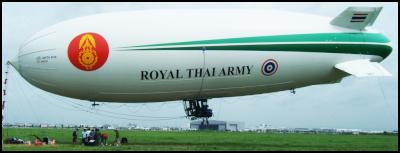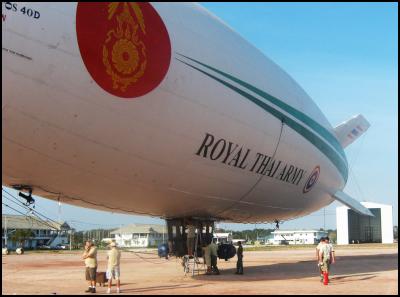U.S. Surveillance Blimp Fights Harsh Criticism
U.S. Surveillance Blimp Fights Harsh Criticism
by Richard S. EhrlichBANGKOK, Thailand -- An Arlington, Virginia-based company is defending its harshly criticized US $ 9.7 million sale of a helium-filled blimp, equipped with infrared thermal cameras, to Thailand's army for hunting Islamist guerrillas in the south.
Scathing criticism of the California-built Sky Dragon blimp, and its cameras, has been repeatedly published in Thailand's media during recent weeks, and voiced by worried politicians.
They describe the airship as a waste of money, not fully able to fly on operational missions, and impractical for Thailand's low-intensity guerrilla war where Muslim rebels hide in hilly jungles.
"We have one last test flight to conduct, and it should be completed within the next week," said Aria International's President and CEO Mike "Bing" Crosby on March 10 in an e-mail interview.
"The only item left is to utilize the long-range microwave system, from the airship to the receive site in the south of Thailand. All of the helicopter-mounted systems have passed all the tests, and the airship is able to transmit to all the local sites.
"We just need to complete one last step in the process," Mr. Crosby said.
"It will be in the very near future, and there is no risk of this not occurring."
Aeros, the blimp's California-based manufacturers, said the Sky Dragon can reach an altitude of 10,000 feet (3,048 meters).
"Yes it can fly at that altitude if necessary. We will, however, very rarely fly at that altitude as there is really no reason do to so," Aria International's Mr. Crosby said.
The system's five surveillance cameras -- two mounted on the airship, and three installed on support helicopters -- do not require complex computer skills to determine what the pictures reveal, he said.
"There is no interpretation of pictures, as it is simply like watching a very good TV with a very clear high-definition picture of exactly what is going on. The training is how to optimize the system, and best utilize the various sensors."
Aria International's initial contract is being fulfilled, and a second contract may be signed soon, he said.
"Everything will have been fulfilled after our last flight test this week. We are hopeful of a follow-on contract, that will keep us in
Thailand as advisors, trainers, and technical representatives for the entire system."
He said, "The RTA (Royal Thai Army) has asked us to train the pilots, system operators, mechanics and ground maintenance crew."
On March 5, an official hand-over ceremony was staged in Pattani province, but on March 10 Mr. Crosby said, "a partial hand-over has occurred" while the surveillance system was being completed.

Photo provided by Aria International
In an interview reply earlier in March, Mr. Crosby said: "The demand to fly the ship daily is there, but it's pointless to fly it if the entire surveillance system is not operational.
Asked what parts were not operational, Mr. Crosby replied: "I cannot give you the details on the surveillance 'system' being installed. This is a confidential issue with the RTA, and I hope you understand the sensitivity.
"There are actual 'bad guys' in the south of Thailand, and the Army is actually working to catch them."
The blimp can function, he said.
"It is performing the missions of providing surveillance to the RTA. The full capability of the airship and the cameras are being employed right now.
"The cameras are able to downlink information to a mobile command vehicle...for field commanders responding to incidents or on patrol with the airborne assets.
"The downlink can also send pictures real-time to a number of other intel centers and operational command locations," Mr. Crosby said.
The blimp's nylon-based skin, however, has suffered problems.
"There was, on a routine inspection, a hole that developed during the deflation of the ship in preparing it to move from U-Tapao to the south" Mr. Crosby said.
"The manufacturer, in accordance with the warranty of the ship, came to Thailand and assisted us in the repairs prior to inflation in the south."
The problem was "solved by repair of the material that holds the helium. The ship is in perfect working order today."

Photo provided by Aria International
To fly the Sky Dragon blimp, "there is a need for ongoing helium to be provided, but it is at the cost of approximately 200,000 baht (6,000 U.S. dollars) per month," he said.
The five digital V-14MSII cameras were manufactured by Axsys Technologies (http://www.axsys.com), based in Grass Valley, California, which was "recently acquired by General Dynamics," he said.
Proud of the V-14 camera's spying ability, its "specs" document displayed a color photograph of a man in a book-lined room, using a desktop computer.

Photo provided by Aria International
"This man -- in an apartment in Los Angeles -- would be extremely surprised to learn that we can read his computer screen from a moving helicopter flying past his window at around one kilometer from his building," the V-14 camera's document said.
The V-14 camera system was demonstrated "most recently at Blackwater's facility in Moyock North Carolina and Manassas Park, Virginia, as well as Nellis Air Force Base in Las Vegas and SOFEX in Jordan," the document said.
"Yes, the cameras as an entire entity are controlled as an export item by the U.S. Department of State Defense Trade Controls section, which also coordinates with the Department of Defense," Mr. Crosby said from Arlington, Virginia, during the interview.
He pointed to U.S. export regulations posted on the State Department's website (http://www.pmddtc.state.gov).
"Yes, these cameras are approved for release to the Royal Thai Army only at this time."
The blimp's laptop-linked, high-definition, zoom cameras "have infra-red/thermal capability" and "are mounted on the airship and in use," Mr. Crosby said.

Photo provided by Aria International
The fat oval blimp has an enclosed gondola constructed from aluminum alloys, attached underneath.
It allows a pilot to fly the Sky Dragon and relay pictures from its cameras to nearby helicopters, vehicles and buildings.
"Aria International Incorporated (www.aria-int.com) is the prime contractor in the contract with the Royal Thai Army (RTA)," Mr. Crosby said.
"There were five surveillance cameras purchased, [including] two that are installed and working on the Worldwide Aeros A-40D Sky Dragon Airship, and three additional cameras on RTA helo's," he said, referring to three support helicopters.
Aeros (http://www.aerosml.com) manufactures the Sky Dragon blimp in Montebello, California.
The single-pilot, 153-foot (46.6-meter) long Sky Dragon uses a three-blade propeller for a maximum flight speed of 51 mph (82 kmh).
It should be able to reach an altitude of 10,000 feet (3,048 meters), Aeros said.
Asked for a breakdown of the U.S. dollars 9.7 million price tag for the blimp, plus the cameras, maintenance, and training for Thais to fly and use the equipment, Mr. Crosby replied:
"Airship equals 2.8 million. Cameras and downlink equipment equals 6 million."
Additional costs included the "price of one armored mobile command vehicle," plus installation, integration and other investments.
Aria International (http://www.aria-int.com) said its contract included "training," "continuing maintenance tasks," "construction of an airship hangar," and "construction of a 12-room hotel for the Aria staff working at the Army base," near the southern town of Pattani.
"To build a prolonged peace process, there should be other, and better, ways to do it on such a large budget," said Worrawit Basu, a senator on the Senate's military committee.
Thailand's two English-language newspapers, The Bangkok Post and The Nation, mocked the blimp's cost, purpose and flying ability.
"The Bangkok Post was horribly incorrect, and made incredible mistakes bordering on liable and clearly unprofessional reporting," Mr. Crosby said.
An editorial cartoon, published in the Bangkok Post on March 6, showed the Sky Dragon leaking gusts of helium despite several sloppy patches, while Thai soldiers clumsily grappled to control it and a senior officer asked: "Does it work?"
"Questions remain as to whether the Sky Dragon can function as planned, whether it is an effective tool against insurgency -- or is it a bigger sham than the GT200?" the Bangkok Post reported.
The useless GT200 is an unrelated alleged hoax involving a British company which convinced Thailand's military, police and other security personnel to spend more than US $ 24 million on pieces of cardboard which were inserted into empty plastic containers, each decorated with a collapsible antenna.
The hundreds of GT200s were touted as bomb and drug detectors, but were recently revealed to be toys.
The government belatedly denounced the GT200, but Thailand's confused military continues to use them while searching for bombs in the south, where more than 4,000 people have died on all sides since 2004, in the worsening Muslim separatist insurgency.
While Thailand continues to wrestle with the GT200 scandal, the English-language Nation newspaper blasted the blimp in an editorial headlined: "Bloated Armed Forces Waste Valuable Resources."
It said: "Besides the fact that the airship makes a big target, its sheer size and slow speed would easily tip off insurgents who reside in just about every village in the deep south.
"Of course, the insurgency in the south has become a great excuse to buy more hardware," said the editorial.
Reporters were banned on March 5 during the blimp's official hand-over to Thailand's 15th Infantry Regiment in the southern province of Pattani.
"The procurement committee must take responsibility if the airship cannot fly," Army Chief Gen. Anupong Paojinda was quoted as saying on March 5.
"If we cannot accept it, we will not pay the final amount to the company."
This Southeast Asian nation is a staunch non-NATO ally of the U.S.
The military toppled an elected government in a September 2006 coup, before allowing a return to elections, and still dominates Thailand's politics and government spending.
The blimp contract was signed in April 2009.
Three months later, Aria said in a media statement's headline: "Blimps Find Favor as Poor Man's Satellite," and hailed the deal as a success.
Richard S Ehrlich is a Bangkok-based journalist who has
reported news from Asia since 1978. He is co-author of
"Hello My Big Big Honey!", a non-fiction book of
investigative journalism. His web page is
http://www.asia-correspondent.110mb.com
(Copyright 2010 Richard S Ehrlich)


 Binoy Kampmark: Ironic Dependency - Russian Uranium And The US Energy Market
Binoy Kampmark: Ironic Dependency - Russian Uranium And The US Energy Market Binoy Kampmark: Arrest Warrants From The Hague - The ICC, Netanyahu And Gallant
Binoy Kampmark: Arrest Warrants From The Hague - The ICC, Netanyahu And Gallant Ian Powell: General Practice Visits, Emergency Department Presentations, And Social Determinants Of Health
Ian Powell: General Practice Visits, Emergency Department Presentations, And Social Determinants Of Health Gordon Campbell: On The Hikoi Aftermath
Gordon Campbell: On The Hikoi Aftermath Eugene Doyle: Has WWIII Started?
Eugene Doyle: Has WWIII Started? Binoy Kampmark: Fencing The Ocean - Australia’s Social Media Safety Bill
Binoy Kampmark: Fencing The Ocean - Australia’s Social Media Safety Bill